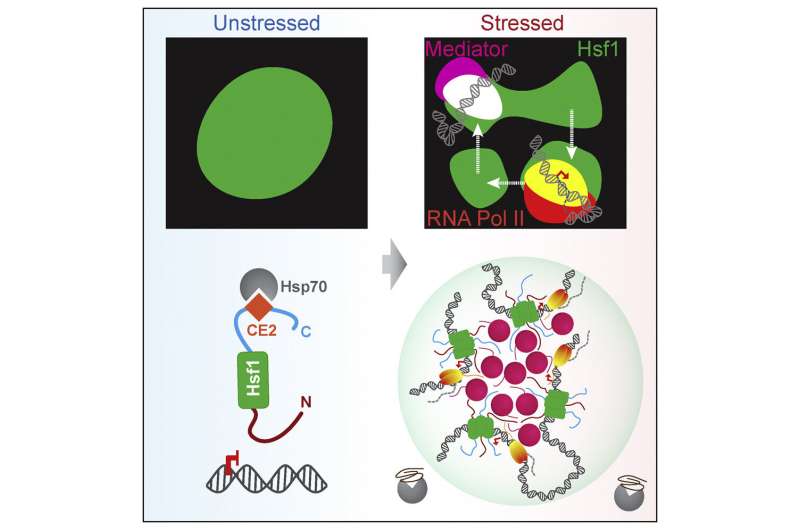'Primordial super-enhancers' provide early snapshot of the mechanisms that allowed for multicellularity

New research at the University of Chicago has found that the same machinery used by mammalian cells to drive cellular differentiation also plays a critical role in activating genes in yeast in response to environmental stress.
The results, which were published in Molecular Cell, suggest that these machines, known as transcriptional condensates, are an ancient, conserved tool used by eukaryotic cells to promote high level gene expression for over a billion years. The findings are helping to not only better explain how cells respond dynamically to environmental cues but also have implications for understanding human diseases such as cancer and neurodegeneration.
The study extends existing research on transcriptional condensates in mammalian cells into yeast and their heat shock response—how cells respond to high temperatures. "The heat shock response is ancient," said David Pincus, Ph.D., Assistant Professor of Molecular Genetics and Cell Biology at UChicago. "This response existed long before there were people—long before there were even yeast. It predates the split between prokaryotes and eukaryotes, so it's a really fundamental and important cellular response."
Transcriptional condensates are membrane-less compartments—almost like organelles, but lacking a membrane—within the nucleus of the cell that bring together and concentrate transcriptional machinery to allow for the rapid and high-level transcription of specific critical genes under certain conditions, such as to specify a cell lineage or in response to stress.
In response to high environmental temperatures, cells turn on molecular chaperones, which act to help maintain protein stability. This heat shock response can be hijacked by cancer cells to help mutated proteins stay folded, and it gets broken down in neurodegenerative diseases such as Alzheimer's disease, where a lack of molecular chaperones leads to excessive protein aggregation.
"We know that this heat shock response is important for human health, and we know that the genes involved get induced at massive amounts," said Pincus. "But it wasn't really clear how cells were able to coordinate this response to drive that gene expression."
Dating back to the dawn of life
Previous research in mammalian cells had shown that eukaryotes use these membrane-less compartments to drive high-level gene expression by creating hubs where relevant DNA sequences and transcriptional activators can collect and drive transcription. In the current study, the researchers used a series of genetic mutations to demonstrate that yeast cells use the same mechanism to coordinate the heat shock response.
"In our prior research, we saw that the genes being regulated in response to heat stress coalesce in 3D space to be activated," said Surabhi Chowdhary, a postdoctoral scholar in the Pincus lab at UChicago. "This study provides evidence that these genes are driven together in 3D space by these biomechanical condensates to facilitate gene transcription."
This is the first time these condensates have been seen in a non-eukaryotic species, demonstrating that these structures are very ancient, dating back to a very early common ancestor and conserved across species. "This means that cells have been doing this high-level gene expression for a billion years," said Pincus. "And when these condensates form, they're not forming at an individual gene, but instead have the capacity to bring a bunch of genes together to activate them all at the same time."
The results also establish a new model for the yeast heat shock response. "Until now it wasn't clear how these genes come together to drive high levels of transcription activity during the stress response," said Chowdhary. "Now we know that the key gene, Hsf1, is acting in an exceptional manner by collecting and concentrating these genes together in these transcriptional condensates, and bringing in other genes to drive this transcription."
The researchers say that this mechanism likely dates back to the dawn of life. "You've heard of the primordial soup, where life began in these concentrated beds of nutrients," said Pincus. "Think of these condensates as 'primordial super-enhancers'. This machinery likely evolved as part of the stress response in primitive cells and later on were leveraged to drive cellular differentiation, paving the way for multicellular life."
Essential processes in action
As a next step, the team plans to further investigate the mechanism of transcriptional condensates, seeking to better understand how the condensates form and how they drive the 3D reorganization of the genome. Ultimately, better understanding the mechanism and its biological significance could pave the way for new medical treatments, if researchers are able to develop drugs that modulate the formation and activity of the condensates directly.
"It's so exciting to know that cells don't leave anything up to chance," said Pincus. "We think of a cell as a loose bag of enzymes, but everything is organized spatially and temporally. It's like we're taking the hood off the car and watching the engine turn and seeing these essential evolutionary processes in action. If cells couldn't' cope with changes in the environment we'd all be toast. It's a beautiful thing to see."
More information: Surabhi Chowdhary et al, Inducible transcriptional condensates drive 3D genome reorganization in the heat shock response, Molecular Cell (2022). DOI: 10.1016/j.molcel.2022.10.013
Journal information: Molecular Cell
Provided by University of Chicago Medical Center





















